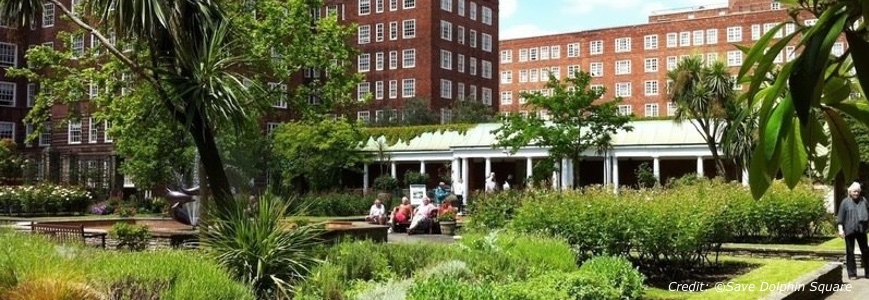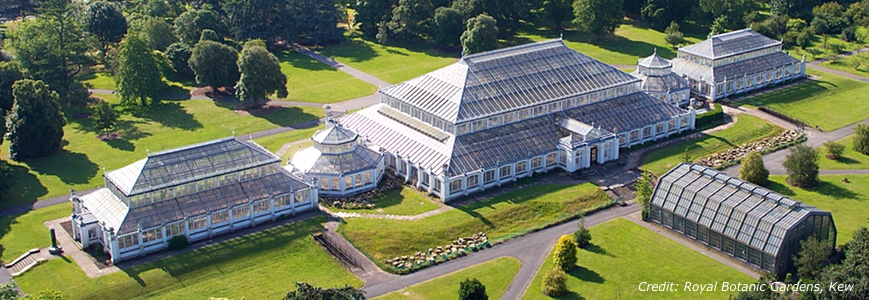THE LANDSCAPING SOLUTIONS BLOG
Welcome to our Blog. Inspiration, updates and industry trends from the team at Landscaping Solutions.
DOLPHIN SQUARE AND ITS LISTED GRADE II GARDENS UNDER THREAT

If you follow us on social media you may have noticed some of our recent posts regarding the iconic Dolphin Square and its Grade II listed gardens.
Built between 1935 and 1937, Dolphin Square is located by the River Thames in London's Pimlico.
As one of the largest and most famous apartment blocks in London, Dolphin Square has had somewhat of a colourful past and has been home to princesses, politicians, spies and actors throughout its 80 year history.
A Conservation Area in its own right, the beautiful and tranquil landscaped gardens were originally designed by Richard Suddell and have just recently been listed Grade II by Historic England.
The site itself has changed hands various times over the years but was most recently acquired by US based property company Westbrook Partners in 2005. Unfortunately, Westbrook have recently put forward a planning application proposing a £400 million revamp of the entire site.
If approved, the plans would see the northern block of Dolphin Square completely demolished. A 10-storey building would then be erected in its place, with an additional floor being added to all the remaining blocks.
Two huge basement areas would then be excavated to allow for an underground swimming pool and sports facilities and the famous art-deco shopping parade would also be demolished as part of the proposed works.
If Westminster Council were to approve the planning work on the five year redevelopment could potentially start as soon as 2020.
The northern half of the listed gardens would be completely lost forever as a result of redevelopment and at the very least, the character and fabric of Dolphin Square would be destroyed.
Westbrook Partners claim to have invested approximately £40 million into the upkeep of Dolphin Square and have stated that the proposed works are a necessary solution to the ongoing repair costs.
The scope of work however is quite clearly an expansion and not a refurbishment and when you take in to account the fact that Westbrook has declined to divulge how many of the new homes would be set aside for affordable housing (a council requirement) it is clear the motive behind the revamp is based purely on profit.
For further information regarding Dolphin Square or to sign the on-line petition to save it please visit the Save Dolphin Square petition page at change.org
TEMPERATE HOUSE AT KEW GARDENS SET TO REOPEN

Closed since 2013 for extensive restorations, the Grade I listed building and largest surviving Victorian glasshouse in the world is set to reopen its doors on 5 May, as the 5 year long and £41m restoration project nears completion.
Originally built in the 1860’s, Temperate House at Kew Royal Botanic Gardens in south-west London, is still laid out according to the original design of its architect, Decimus Burton. Covering 4,880 square metres it houses an impressive collection of international, rare and almost extinct plants from places such as the the Mediterranean, Africa, Australia, New Zealand, Asia and the Pacific Islands.
When it first opened its doors to the public in 1863 crowds flocked for the chance to see plants and exotic environments, that previously could only have been read about. Although a huge success with the public the ambitious project unfortunately ran well over its original budget and wasn’t actually completed for another 40 years.
In a desperate attempt to control the spiralling budget cost cutting measures were implemented, some of which involved cheaper building materials and questionable construction methods. Unfortunately this meant that over a century later the condition of the structure had become a major issue.
To ensure its conservation, the major overhaul of Temperate House began back in 2013. For the restoration work to be carried out over 500 plants were potted up and moved to other nurseries within the gardens. Plants deemed too large and fragile to be moved were left in situ, with provisions made to box them in for protection.
Once all the plants were either moved or protected, restoration work could begin. Over the past 5 years every single glass panel has been replaced, decorative ironwork restored and rotten timber repaired. In addition to the restoration and repair work the entire heating system was also replaced with a more environmentally friendly and energy efficient system.
The restoration project has been a massive undertaking and with the grand reopening looming ever closer, teams of gardeners are now busy with the delicate task of replanting the vast number of plants in to their new beds. In fact, it is estimated that a staggering 10,000 plants (new and old) will eventually have been planted in time for the reopening.
We will certainly be paying the new Temperate House a visit once it reopens in May and if you would like to do so yourself, further information regarding the reopening can be found at kew.org.
DOES A GARDEN ADD TO THE VALUE OF YOUR HOME?

As you would expect, the majority of people go to great lengths when sprucing up their homes in the hope of making a sale. In the past gardens would foolishly be overlooked in this process, their potential undervalued by homeowners and prospective buyers alike.
But times have changed. Almost 40% of Brits now spend more time in their gardens compared to five years ago.
Over the years homeowners have begun to take more and more pride in the layout and landscaping of their gardens, with buyers also following suit, putting the same emphasis on the garden as they do other rooms when viewing a property. The garden is becoming an integral consideration in the house buying process.
A huge part of selling a house is standing out from the crowd. Large or small, the condition and appearance of a property’s garden is going to play a part in successfully achieving that.
First impressions count and in many cases the garden is the first thing a person sees when arriving at your property. A badly maintained garden could be enough to put off a potential buyer before they even set foot inside.
Research recently conducted by property buying website “Sell House Fast” surveyed estate agents, garden designers, landscape gardeners, property professionals and consultants. The results found that a well-maintained garden can add up to 20% to the value of your property. Based on the current UK average for property prices that’s £60,000, and up to £90,000 for properties in London.
We’re not necessarily talking about acres of land either. The majority of the estate agents surveyed agreed that even a small garden or courtyard, if well crafted, would certainly be worth more than a similar property on the same street where nothing had been done.
In a separate survey conducted by estate agent Foxtons it was also found that 72% of their clients said they would pay more for a home with a garden.
What is certain from all this is that a well-maintained outdoor space is more in demand then ever before and if you are thinking of selling up in the near future, your garden could easily be the deal breaker.
If you have found this article interesting you may also enjoy one of our previous articles; The Importance Of Good Garden Design And Landscaping.
CROWDFUNDING SUCCESS FOR CAMDEN HIGH LINE

Back in June of this year we did a piece on the Landscaping Solutions blog covering the Camden High Line, an ambitious project providing London with its own answer to New York City’s famous ‘High Line’.
The project aims to transform an old section of raised railway track in North London into an elevated public garden and commuting route.
Proposed by local business development agency Camden Town Unlimited, the belief is that the completed project will positively impact the local residents and surrounding neighbourhoods and serve as a shining example of how existing urban infrastructure can be repurposed and reimagined to do more.
With plans and conceptual art in place, Camden Town Unlimited set about launching a crowdfunding campaign to raise funds for taking the project through to the next stage. This includes site appraisals and surveys to establish the condition of the existing infrastructure as well as setting out the resources required to transform the disused railway.
Organisers initially set out to raise £37,000 for the proposed work but within a month of launching the campaign it had raised a staggering £62,000, over one and a half times their original goal.
This was undoubtably due in part to the overwhelming support the project received from the outset with over 300 local residents, community groups and businesses donating to the campaign, as well as Camden Market and the Mayor of London himself, Sadiq Khan.
When asked about the plans Mr Khan said: “This innovative project has the potential to become a real asset for Camden and is a great example of a community taking an idea and garnering support in order to make it a reality. I look forward to seeing it develop”.
Camden Town Unlimited are said to be thrilled with the results of the crowdfunding campaign as well as the support of the local community, businesses and the London mayor.
Whilst there is still a long way to go it is a very significant step towards construction and realising Camden Town Unlimited’s vision of a vibrant public green space and commuting route.
Refreshingly there have been a number of projects of this nature launched over recent months and as council budgets are stripped back across the UK, more and more communities are turning to crowdfunding as a means of getting community projects off the ground.
So many of these structures and spaces would no doubt have remained unloved and wasted for years to come were it not for these types of projects. Repurposing derelict or neglected spaces such as the Camden High Line re-energises the urban landscape, benefiting neighbourhoods as a whole and bringing communities together.
For further information regarding the Camden High Line or to support the project through its crowdfunding page click here.
If you would like to read our original blog article covering the launch of the Camden High Line crowdfunding campaign click here: From New York To London - The Camden High Line.